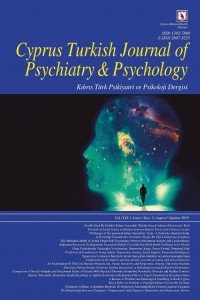Öz
In this study, it was aimed to investigate the mediating role of actual-ought self-discrepancy between attachment anxiety and codependence among a group of international university students in Turkey who are fluent in English. Considering the high intensity of agitation-related emotions in individuals with codependence, it is hypothesized that discrepancies between actual and ought to self-states
scores are mediating the relationship between preoccupied-anxious attachment style and codependence scores. Data was collected between March and May 2016 from 67 (34 females, 33 males) university students with at least one dysfunctional significant other. They were recruited via e-mails and web-based online survey applications. The age range of the participants is between 18 and 25 (M=21, SD=2.074). In addition to a short socio-demographic information form, three self-report instruments were administered to participants: The Revised Adult Attachment Scale (RAAS), the Self Concept Questionnaire – Conventional
Constructs (SCQ-CC), and the Codependent Questionnaire (CdQ). Regression and mediation analyses were utilized, and it was found that actual-ought self-discrepancies scores to mediate the relationship between preoccupied-anxious attachment and codependence scores. The results of the study are expected to have important implications for clinical interventions and prevention programs in addressing the attachment insecurities and emotion regulation difficulties of the individuals with codependence.
Anahtar Kelimeler
Attachment Self-Discrepancy Codependence Emotion Regulation Intimate Relationship
Kaynakça
- Ainsworth, M. D. S. (1982). Attachment: Retrospect and prospect. In C. M. Parkes& J. Stevenson-Hinde (Eds.), The place of attachment in human behavior (pp. 3-30). New York: Basic Books.
- Ainsworth, M. D. S., Blehar, M. C., Waters, E., & Wall, S. (1978). Patterns of attachment: A psychological study of the Strange Situation. Hillsdale, NJ: Erlbaum.
- Barnett, M. D., & Womack, P. M.(2015). Fearing, not loving, the reflection: Narcissism, self-esteem, and self-discrepancy theory. Personality and Individual Differences, 74, 280-284.
- Bartholomew, K., & Horowitz, L. M. (1991). Attachment styles among youngadults: A test of a four-category model. Journal of Personality and Social Psychology, 61, 226–244.
- Bowlby, J. (1969). Attachment and loss: Vol. 1. Attachment. New York: Basic Books.
- Bowlby, J. (1973). Attachment and loss: Vol. 2. Separation: Anxiety and anger. NewYork: Basic Books.
- Bowlby, J. (1980). Attachment and loss: Vol. 3. Loss: Sadness and depression. New York: Basic Books.
- Bowlby, J. (1982). Attachment and loss: Vol. 1. Attachment (2nd ed.). New York: BasicBooks.
- Bowlby, J. (1988). A secure base: Clinical applications of attachment theory. London:Routledge.
- Calderwood, K. A., &Rajesparam, A. (2014). Applying the codependency concept to concerned significant others of problem gamblers: Words of caution. Journal of ambling Issues, 29, 1-16.
- Cermak, T. (1986). Diagnostic criteria for co-dependency. Journal of Psychoactive Drugs, 18, 15-20.
- Collins, N. L., & Read, S. J. (1990). Adult attachment, working models, and relationship quality in couples. Journal of Personality and Social Psychology, 54, 644-663.
- Collins, N. L. (1996). Working Models of Attachment: Implications for Explanation, Emotion, and Behavior. Journal of Personality and Social Psychology, 71 (4), 810- 832.
- Daire, A. P., Jacobson, L., & Carlson, R. G. (2012). Emotional stocks and bonds:A metaphorical model for conceptualizing and treating codependency and other forms of emotional overinvesting. American Journal of Psychotherapy, 66 (3), 259-278.
- Doweiko, H. E. (2009). Concepts of chemical dependency (7thed.). Belmont: Thomson Higher Education.
- Gan, M., & Chen, Serena (2017). Being Your Actual or Ideal Self? What It Means to Feel Authentic in a Relationship. Personality and Social Psychology Bulletin, 43 (4), 465-478.
- Higgins, E. T. (1987). Self-discrepancy theory: A theory relating self and affect.Psychological Review, 94, 319–340.
- Knudson, T. M., & Terrell, H. K. (2012). Codependency, perceived interparental conflict, and substance abuse in the family of origin. The American Journal of Family Therapy, 40 (2), 245-257.
- Lampis, J., Cataudella, S., Busonera, A., &Skowron, E. A. (2017). The role of differentiation of self and dyadic adjustment in predicting codependency. Contemporary Family Therapy, 39 (1), 62-72.
- Mikulincer, M., Gillath, O., & Shaver, P. R. (2002). Activation of the attachment system in adulthood: Threatrelated primes increase the accessibility of mental representations of attachment figures. Journal of Personality and Social Psychology, 83, 881–895.
- Mikulincer, M., & Shaver, P. R. (2004). Security-Based SelfRepresentations in Adulthood: Contents and Processes. In Rholes, S. & Simpson, J. (Eds.), Adult Attachment: Theory, Research and Clinical Implications (pp.159-195). Guilford Press: NY.
- Rholes, W. S., & Simpson, J. A. (2004). Attachment theory: Basic concepts and contemporary questions. In Rholes, S. & Simpson, J. (Eds.), Adult Attachment: Theory, Research and Clinical Implications (pp.3-16). Guilford Press: NY.
- Roehling, P. V., &Gaumond, E. (1996). Reliability and validity of the codependent questionnaire. Alcoholism Treatment Quarterly, 14, 85-95.
- Shaver, P. R., &Mikulincer, M. (2004). Attachment theory: Basic concepts and contemporary questions. In Rholes, S. & Simpson, J. (Eds.), What do self-report attachment measures assess? (pp.17-54). Guilford Press: NY.
- Watson, N., & Watts, R. H., Jr. (2001). The predictive strength of personal constructs versus conventional constructs: Self-image disparity and neuroticism. Journal of Personality, 69, 121-143.
- Watson, N., Bryan, C., & Thrash, T. M. (2010). SelfDiscrepancy: Comparisons of the psychometric properties of three instruments. Psychological Assessment, 22, 878-892.
- Watson, N., Bryan, B. C., & Thrash, T. M. (2016). Selfdiscrepancy: Long-term test–retest reliability and test– criterion predictive validity. Psychological Assessment, 28 (1), 59-69.
- Wegscheider-Cruse, S. (1985). Choice-making for spirituality seekers, co-dependents and adult children. Pompano Beach, FL: Health Communications.
- Winter, K. (2018). Experiences and expertise of codependency: Repetition, claim-coupling, and enthusiasm.Public Understanding of Science, 28 (2), 146- 160.
Ayrıntılar
| Birincil Dil | İngilizce |
|---|---|
| Konular | Psikoloji |
| Bölüm | Araştırma Makaleleri |
| Yazarlar | |
| Yayımlanma Tarihi | 10 Ağustos 2019 |
| Kabul Tarihi | 22 Temmuz 2019 |
| Yayımlandığı Sayı | Yıl 2019 Cilt: 1 Sayı: 2 |


